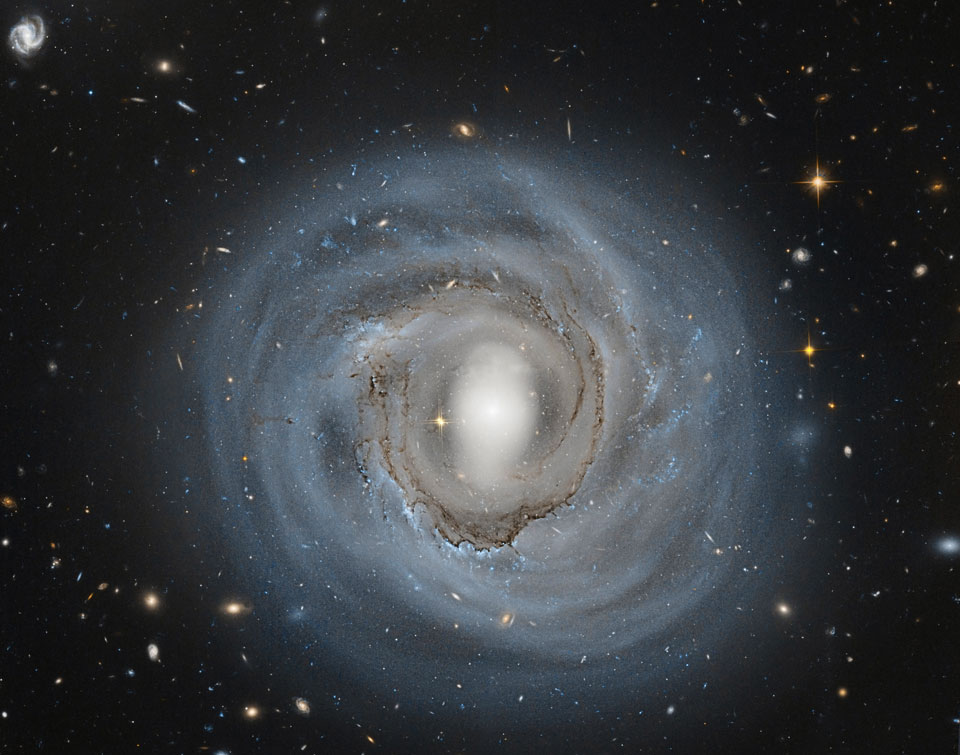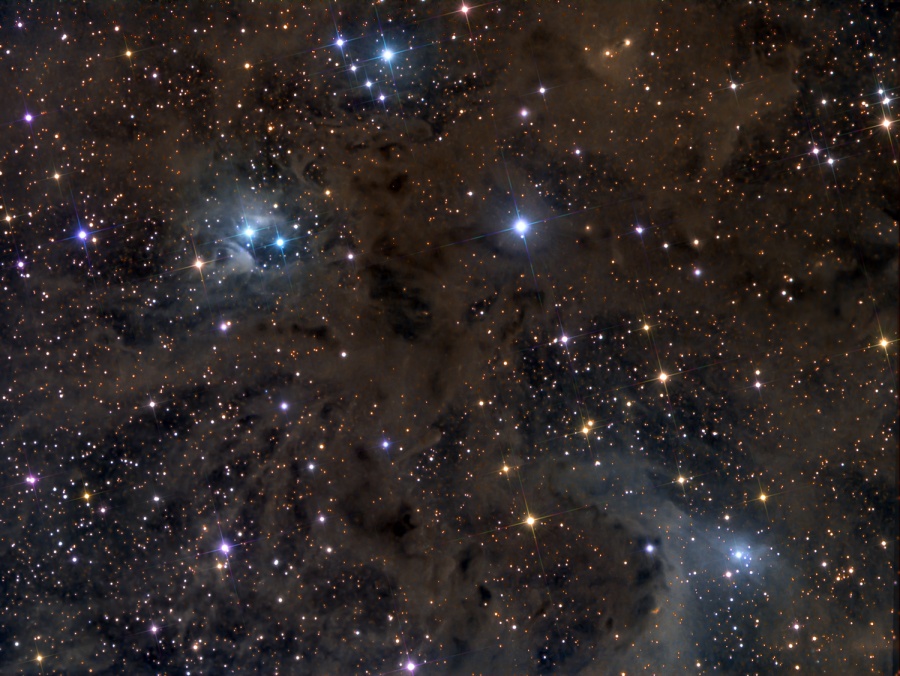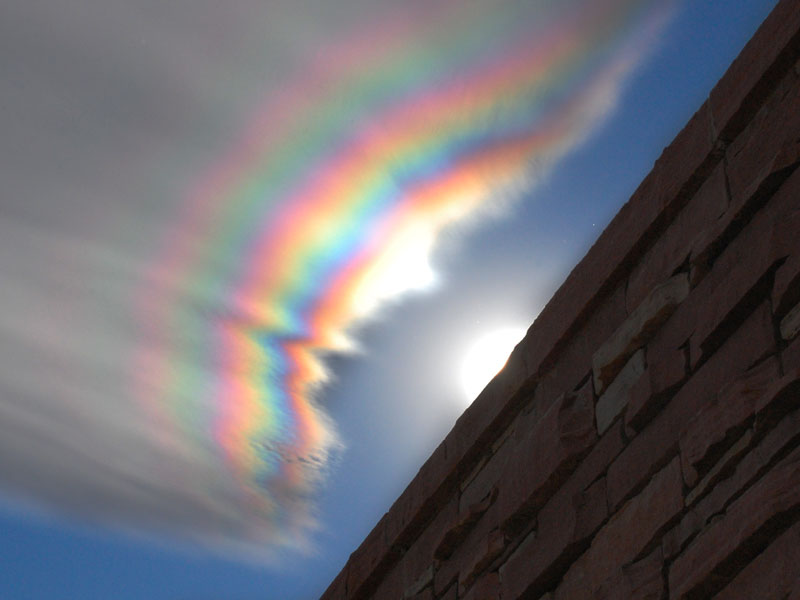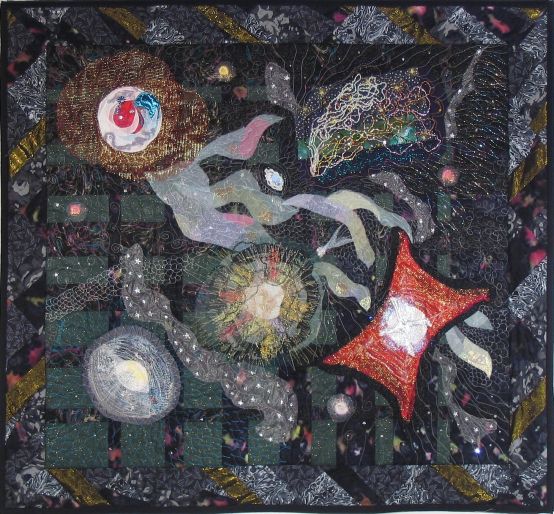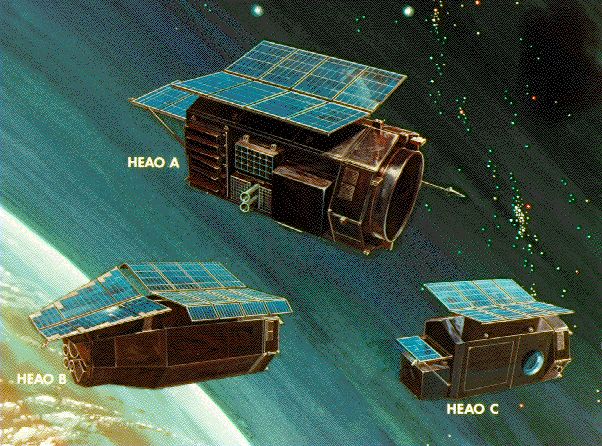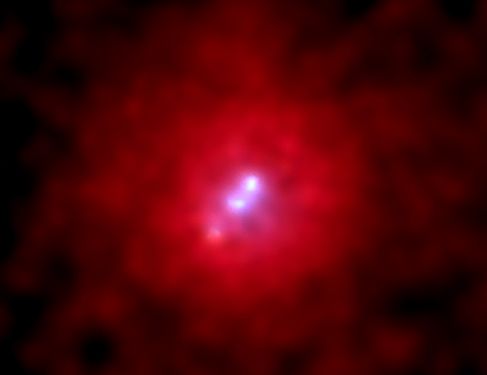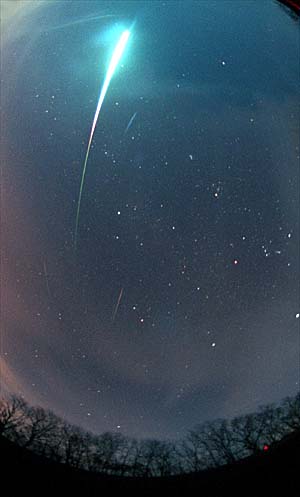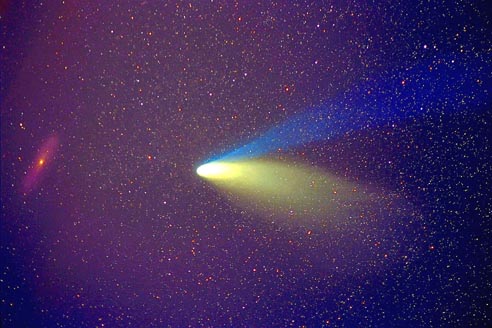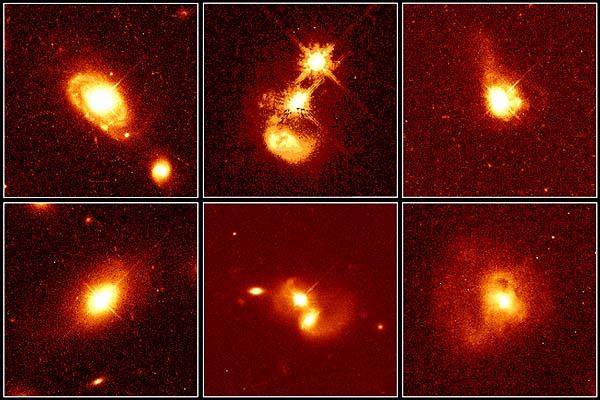| << Previous | Index | Next >> |
2014
[imghover6=http://apod.nasa.gov/apod/image/1411/la ... _1080c.jpg]http://apod.nasa.gov/apod/image/1411/la ... d_1080.jpg[/imghover6]Image Credit & Copyright: Derek Demeter (Emil Buehler Planetarium)
2013 How far away is spiral galaxy NGC 4921? Although presently estimated to be about 310 million light years distant, a more precise determination could be coupled with its known recession speed to help humanity better calibrate the expansion rate of the entire visible universe. Toward this goal, several images were taken by the Hubble Space Telescope in order to help identify key stellar distance markers known as Cepheid variable stars. Since NGC 4921 is a member of the Coma Cluster of Galaxies, refining its distance would also allow a better distance determination to one of the largest nearby clusters in the local universe. The magnificent spiral NGC 4921 has been informally dubbed anemic because of its low rate of star formation and low surface brightness. Visible in the above image are, from the center, a bright nucleus, a bright central bar, a prominent ring of dark dust, blue clusters of recently formed stars, several smaller companion galaxies, unrelated galaxies in the far distant universe, and unrelated stars in our Milky Way Galaxy.
2012 They might look like trees on Mars, but they're not. Groups of dark brown streaks have been photographed by the Mars Reconnaissance Orbiter on melting pinkish sand dunes covered with light frost. The above image was taken in 2008 April near the North Pole of Mars. At that time, dark sand on the interior of Martian sand dunes became more and more visible as the spring Sun melted the lighter carbon dioxide ice. When occurring near the top of a dune, dark sand may cascade down the dune leaving dark surface streaks -- streaks that might appear at first to be trees standing in front of the lighter regions, but cast no shadows. Objects about 25 centimeters across are resolved on this image spanning about one kilometer. Close ups of some parts of this image show billowing plumes indicating that the sand slides were occurring even when the image was being taken.
2011 A tantalizing glimpse inside this dome was captured after sunset at the mountain top Pic Du Midi Observatory in the French Pyrenees. But while most are just beginning their work at sunset, this observatory's day was done. The instrument looming within is CLIMSO (for Christian Latouche IMageur Solaire), dedicated to exploring dynamic phenomena across the surface and atmosphere of the Sun. To image the solar atmosphere or corona, CLIMSO uses coronagraphs. Developed by French astronomer Bernard Lyot in the 1930s, coronagraphs block light from the center of the telescope beam to create an artificial solar eclipse and allow a continuous view of the solar corona. In this surreal twilight scene above a sea of clouds, the dome's interior was revealed by the single, long exposure as the open slit rotated across the field of view.
2010 This composition in stardust covers almost 2 degrees on the sky, close to the border of the zodiacal constellation Aries and the plane of our Milky Way Galaxy. At the lower right of the gorgeous skyscape is a dusty blue reflection nebula surrounding a bright star cataloged as van den Bergh 13 (vdB 13), about 1,000 light-years away. At that estimated distance, the cosmic canvas is over 30 light-years across. Also surrounded by scattered blue starlight, vdB 16 lies toward the upper left, while dark dusty nebulae sprawl across the scene. Near the edge of a large molecular cloud, they can hide newly formed stars and young stellar objects or protostars from prying optical telescopes. Collapsing due to self-gravity, the protostars form around dense cores embedded in the molecular cloud.
2009 If you could go far away from the Earth and look around the entire sky -- what would you see? Such was the goal of the All-Sky Milky Way Panorama 2.0 project of Axel Mellinger. Presented above is the result: a digital compilation of over 3,000 images comprising the highest resolution digital panorama of the entire night sky yet created. An interactive zoom version, featuring over 500 million pixels, can be found here. Every fixed astronomical object visible to the unaided eye has been imaged, including every constellation, every nebula, and every star cluster. Moreover, millions of individual stars are also visible, all in our Milky Way Galaxy, and many a thousand times fainter than a human can see. Dark filaments of dust lace the central band of our Milky Way Galaxy, visible across the image center. The satellite galaxies Large and Small Magellanic Clouds are visible on the lower right. This was not the first time Dr. Mellinger has embarked on such a project: the results of his first All-Sky Milky Way Panorama Project, taken using photographic film, are visible here.
2008
Click to play embedded YouTube video.
Credit & Copyright Global Television Edmonton, YouTube
2007 Why would a cloud appear to be different colors? A relatively rare phenomenon known as iridescent clouds can show unusual colors vividly or a whole spectrum of colors simultaneously. These clouds are formed of small water droplets of nearly uniform size. When the Sun is in the right position and mostly hidden by thick clouds, these thinner clouds significantly diffract sunlight in a nearly coherent manner, with different colors being deflected by different amounts. Therefore, different colors will come to the observer from slightly different directions. Many clouds start with uniform regions that could show iridescence but quickly become too thick, too mixed, or too far from the Sun to exhibit striking colors. This iridescent cloud was photographed above Boulder, Colorado last week.
2006 Mercury is now visible shortly before dawn, the brightest "star" just above the eastern horizon. But almost two weeks ago Mercury actually crossed the face of the Sun for the second time in the 21st century. Viewed with red/blue glasses, this stereo anaglyph combines space-based images of the Sun and innermost planet in a just-for-fun 3D presentation of the Mercury transit. The solar disk image is from Hinode. (sounds like "hee-no-day", means sunrise). A sun-staring observatory, Hinode was launched from Uchinoura Space Center and viewed the transit from Earth orbit. Superimposed on Mercury's dark silhouette is a detailed image of the planet's rugged surface based on data from the Mariner 10 probe that flew by Mercury in 1974 and 1975.
2005 Last week, the nearly Full Moon set along the northern horizon - as seen from Davis Station, Antarctica. The squashed orange pumpkin shape just silhouettes the peak of a distant iceberg in this stunning view. The Moon's apparently squashed shape is due to atmospheric bending of light or refraction - an effect which is more severe closer to the horizon. Skimming low along the stark features of the frozen landscape, the Moon's lower edge appears noticeably more distorted than the upper limb. Along with about 70 others present at Davis Station, Dr. Jim Behrens had a chance to enjoy the view while studying the ongoing detachment of a large iceberg known as "Loose Tooth".
2004 In this striking 41 inch by 38 inch quilt, astronomy enthusiast Judy Ross has interpreted some of the Hubble Space Telescope's best galactic and extragalactic vistas. Featured in past APODs, clockwise from the lower right are; the Red Rectangle Nebula, the Eskimo Nebula, the Sleeping Beauty Galaxy, V838 Monocerotis - the Milky Way's most mysterious star, and supernova remnant N49 - the cosmic debris from an exploded star. Of course, quilts have been used historically to represent astronomical concepts. And while inspired by the images of the cosmos that she incorporates into her quilts, Ross reports that she is still a little daunted by the intricacies of the Cat's Eye Nebula revealed by the Hubble's sharp vision.
2003 The 2003 Leonids Meteor Shower contained relatively few meteors. As expected and unlike the last few years, the Earth just did not pass through any dense particle streams left over by the Sun-orbiting Comet Tempel-Tuttle. Preliminary reports had the peak meteor rates only as high as about one relatively faint meteor a minute even from good locations at good times. Pictured above is one of the brighter Leonids of 2003, caught by one of the continuously operating night sky web cameras (CONCAMs) of the global Night Sky Live project. The fisheye image shows the night sky from horizon to horizon above Mauna Kea, Hawaii, USA. The image is annotated with several bright stars and planets. Note that this meteor, as do all Leonids, appears to emanate from the constellation Leo, labeled on the upper left. Although the peak of the Leonids this year was on November 19, this meteor flashed through the sky the next night.
2002 Why does the Earth have a magnetic field? The electrical conductivity of the molten plasma of the Earth's core should be able to damp the current magnetic field in only thousands of years. Yet our five billion year old Earth clearly causes magnets to point to (defined) north. The mystery is still being studied but recently thought related to motions in the Earth's liquid outer core. Specifically, as portions of the outer core cool and fall inward, oceans of the liquid iron-rich magma rise outward, forced into a helical motion by the spin of the Earth. This motion, many geologists now believe, regenerates Earth's magnetism. Pictured above, a computer simulation shows the resulting magnetic field lines out to two Earth radii, with blue lines directed inward and yellow lines directed outward.
2001 Newborn stars are forming in the Eagle Nebula. This image, taken with the Hubble Space Telescope in 1995, shows evaporating gaseous globules (EGGs) emerging from pillars of molecular hydrogen gas and dust. The giant pillars are light years in length and are so dense that interior gas contracts gravitationally to form stars. At each pillars' end, the intense radiation of bright young stars causes low density material to boil away, leaving stellar nurseries of dense EGGs exposed. The Eagle Nebula, associated with the open star cluster M16, lies about 7000 light years away.
2000 Like a fleet of futuristic starcruisers, NASA's highly successful series of High Energy Astrophysical Observatory (HEAO) spacecraft appear poised over planet Earth. Labeled A, B, and C in this vintage illustration, the spacebased telescopes were known as HEAO-1, HEAO-2, and HEAO-3 respectively. HEAO-1 and HEAO-2 were responsible for revealing to earthlings the wonders of the x-ray sky, discovering 1,000s of celestial sources of high-energy radiation. HEAO-2, also known as the Einstein Observatory, was launched in November 1978, near the date of the famous physicist's 100th birthday and was the first large, fully imaging x-ray telescope in space. HEAO-3, the last in the series, was launched in 1979 and measured high energy cosmic-ray particles and gamma-rays. These satellite observatories were roughly 18 feet long and weighed about 7,000 pounds. Their missions completed, all have fallen from orbit and burned up harmessly in the atmosphere.
1999 Did this galaxy eat too much? Five billion light-years away, the giant elliptical galaxy 3C295 is a prodigious source of energy at radio wavelengths. Bright knots of X-ray emission are also seen at the center of this false-color Chandra Observatory image of the region. The X-ray and radio emission are believed to be the result of an explosive event triggered when too much material flowed into a supermassive black hole at the heart of the giant galaxy. Additionally, the Chandra picture beautifully reveals an extensive cloud of 50 million degree gas surrounding 3C295. Embedded in the cloud is a cluster of about 100 galaxies, too cool to be seen in the X-ray picture. About two million light-years across, the X-ray hot cloud itself contains enough material to create another 1,000 galaxies or so making the cluster and cloud among the most massive objects in the Universe. However, X-ray data indicate that there is still not enough observed mass to hold the cloud and cluster together gravitationally, suggesting the presence of large amounts of dark matter.
1998 The 1998 Leonid Meteor Shower featured many bright events. Extremely bright meteors, known as bolides or fireballs, can briefly glow brighter than the full moon. Pictured above is a Leonid bolide caught during a five-minute, wide-angle exposure. The bolide was so bright it lit up the surrounding area, making otherwise dark trees visible. Also visible are at least three other meteors, numerous bright stars, and the constellation Orion. This meteor shower is called the Leonids because most of the meteors move out from the constellation Leo. At this location near the Powell Observatory in Kansas, over 200 meteors per hour were reported.
1997 The Moon almost ruined this photograph. During late March and early April, Comet Hale-Bopp passed nearly in front of the Andromeda Galaxy. Here the Great Comet of 1997 and the Great Galaxy in Andromeda were photographed together on March 24th. The problem was the brightness of the Moon. The Moon was full that night and so bright that long exposures meant to capture the tails of Hale-Bopp and the disk of M31 would capture instead only moonlight reflected off the Earth's atmosphere. By the time the Moon would set, this opportunity would be gone. That's why this picture was taken during the lunar eclipse.
1996 QUASARs (QUASi-stellAR objects) lie near the edge of the observable Universe. Discovered in 1963, astronomers were astounded - to be visible at such extreme distances of billions of light-years they must emit prodigious amounts of energy. Where does the energy come from? Many believe the quasar's central engine is a giant black hole fueled by tremendous amounts of infalling gas, dust, and stars. This recently released gallery of quasar portraits from the Hubble Space Telescope offers a look at their local neighborhoods: the quasars themselves appear as the bright star-like objects with diffraction spikes. The images in the center and right hand columns reveal quasars associated with disrupted colliding and merging galaxies which should provide plenty of debris to feed a hungry black hole. Yet, in the left hand column a quasar is seen at the center of an otherwise normal looking spiral (above) and elliptical galaxy. Whatever the secret of the quasar's energy, all these sites must provide fuel for its central engine.
1995 Enceladus orbits Saturn between the smaller Mimas and the larger Tethys. Enceladus is composed mostly of water ice and has the cleanest and purest ice surface in the Solar System. It's surface therefore appears nearly white. The surface also has many unusual groves and relatively few craters, like Jupiter's moon Ganymede. This indicates that the surface is young and/or newly reformed. To explain this, some astronomers speculate that Enceladus is susceptible to some sort of volcanic activity. Enceladus was originally discovered in 1789 by William Herschel.
| << Previous | Index | Next >> |
